With the March 25 trade deadline fast approaching, Hoops Rumors is taking a closer look at players around the NBA who are candidates to be moved this month, breaking them down into several categories based on their age, contracts, on-court value, and other categories. Today, we’ll zero in on players with mid-sized expiring contracts who could be useful salary-matching pieces for deadline buyers.
NBA players on expiring contracts are, by definition, nearly all trade candidates. Many of those players aren’t in their teams’ long-term plans, and even the ones that are viewed as keepers could be shopped if a team isn’t fully confident in its ability to re-sign them.
There are a few exceptions, especially among players who have already been recently traded. The Lakers and Cavaliers gave up first-round picks to acquire Dennis Schröder and Jarrett Allen, respectively — given the price they paid, it seems clear they plan to re-sign those players and aren’t expected to shop them this month. That’s especially true for the Bucks and Jrue Holiday, whose price tag via trade was much steeper.
Most players on expiring contracts are at least at a little risk of being dealt though, so many of those players will be the ones we explore in our Trade Candidate series this week and next week.
On Monday, we examined several players who will be eligible for restricted free agency this summer. Today, we’re shifting our focus to a group of players on mid-sized expiring contracts who may be viewed as expendable salary-matching pieces by teams looking to upgrade their rosters.
Let’s dive in…
Regular rotation players who would be available for an upgrade:
- Danny Green, Sixers
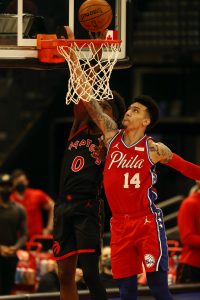
- Cody Zeller, Hornets
- Andre Iguodala, Heat
- Kelly Olynyk, Heat
- Will Barton, Nuggets
- Tony Snell, Hawks
- Doug McDermott, Pacers
These players are ones who are earning regular minutes for teams with playoff – or championship – aspirations. Some of them are having pretty nice seasons — Snell, for instance, is shooting an otherworldly 56.5% on three-point shots through 23 games. McDermott is averaging a career-best 13.2 points per game.
However, it’s hard to imagine any of these guys would be off-limits if their teams had the opportunity to include them in a package for an impact player, or even just a rotation upgrade.
Green, Zeller, and Iguodala are three of the most intriguing trade chips here. They all earn right around $15MM, so even without attaching another player, they could be used to acquire anyone earning in the $10-20MM range. All three teams are good bets to pursue deadline upgrades too — the Sixers and Heat will be among the top threats to come out of the East, while the Hornets would like to secure a playoff spot for the first time since 2016.
Olynyk ($12.6MM), Barton ($13.7MM), and Snell ($12.2MM) are also interesting salary-matching pieces for their respective teams, though trade partners may be wary of Barton’s $14.7MM player option for 2021/22 — if there’s any expectation he’ll pick up that option, he can’t be viewed as a true expiring contract.
At just $7.3MM, McDermott is a less versatile trade chip than the rest, but he’s still worth mentioning, since he’s the highest-paid Pacer who doesn’t have at least one more guaranteed year left on his deal after 2020/21. He’s also a relative bargain at that price and an excellent shooter whose Bird rights would be valuable. Presumably, he’d only be available in a package for a borderline star.
Players who would primarily be salary ballast:
- Gorgui Dieng, Grizzlies
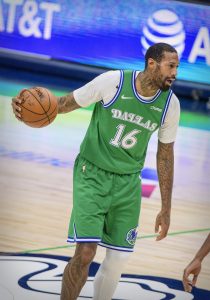
- James Johnson, Mavericks
- Rodney Hood, Trail Blazers
- Meyers Leonard, Heat
- Cristiano Felicio, Bulls
Dieng ($17.3MM) and Johnson ($16MM) are still certainly capable of playing good minutes, but they’ve been racking up DNP-CDs as of late, and their pricey salaries hurt their value.
While Dieng is a viable trade candidate, Dallas is probably more likely than Memphis to attempt to make a splash at the deadline. If so, Johnson would be more expendable than Tim Hardaway Jr. ($19MM), who is also on an expiring deal but is playing a key role for the Mavericks.
Hood ($10MM) may need more time before he’s fully recovered from the Achilles tear that sidelined him in 2019/20 — he has had his worst season since entering the NBA and his $10.9MM salary for next season is non-guaranteed, so he’ll be the Trail Blazers’ most logical salary-matching candidate as they peruse the trade market.
Leonard ($9.4MM) is one of three Heat veterans on expiring contracts who could be on the move, and has become the most dispensable, due to a season-ending shoulder injury and an off-court incident that involved him uttering an anti-Semitic slur. If he’s dealt, it’s probably safe to assume his new team will cut him pretty quickly.
As for Felicio ($7.5MM), he has been a trade candidate almost since the moment he signed an outsized four-year contract in 2017. It’s not clear yet if the Bulls will be buyers or sellers, but if they seek out a minor upgrade, Felicio would be far easier to move than Otto Porter ($28.5MM).
The wild cards:
- Rudy Gay and Patty Mills, Spurs
- Kelly Oubre, Warriors
- Spencer Dinwiddie, Nets
- Aron Baynes, Raptors
These players don’t comfortably fit into either of the first two categories for a handful of reasons. In the cases of Gay ($14.5MM), Mills ($13.5MM), and Oubre ($14.4MM), it’s simply not clear what the Spurs’ and Warriors’ deadline intentions are.
If San Antonio is ready to hand the reins to its young players, the team could fetch a decent return for veterans like Gay and Mills. But the Spurs are currently 18-14 and don’t generally make major deadline deals, so their vets may just stay put — that applies to LaMarcus Aldridge as well, whose $24MM expiring salary is too large to be considered “mid-sized.”
The Warriors, meanwhile, have the assets necessary to be aggressive and pursue an upgrade at the deadline, perhaps using Oubre and the Timberwolves’ 2021 first-round pick. But Golden State is a No. 9 seed in the West and won’t have Klay Thompson available this season, so going all-in might not make sense. The club could just as easily shop Oubre for an asset or two that could eventually be packaged with the Wolves’ pick in a future package.
I nearly put Dinwiddie ($11.5MM) in the “salary ballast” group above, since he’ll likely miss the rest of 2020/21 due to a knee injury. But he averaged 20.6 PPG a year ago and his Bird rights have value — he may be expendable from the Nets’ point of view, since he won’t play this season and the team has a pair of All-Stars in its backcourt going forward, but he’s more than just a salary throw-in.
As for Baynes ($7MM), he could theoretically be placed in either of the first two sections above. He has started 26 games at center for the Raptors and remains a rotation regular, but he’s having a down year and almost certainly won’t be a part of the club’s future plans. If Toronto makes a deadline deal, whether as a seller or buyer, Baynes seems like a good bet to be part of it.
Photos courtesy of USA Today Sports Images.
 Last November, the Timberwolves
Last November, the Timberwolves 
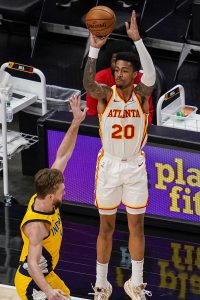
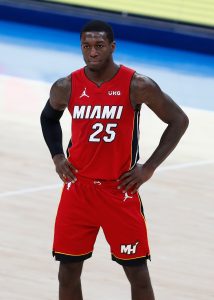

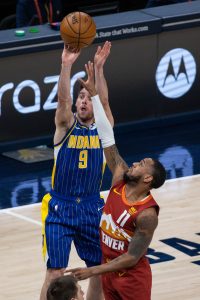 T.J. McConnell
T.J. McConnell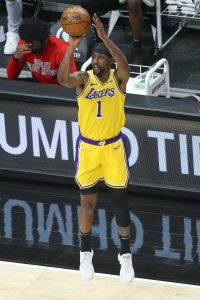
 When Embiid first signed his five-year, maximum-salary contract with the Sixers back in 2017, he had appeared in just 31 games over the course of his first three NBA seasons, making the investment a risky one. The deal included some injury protection for Philadelphia, giving the team the ability to waive Embiid without fully guaranteeing the salaries in later years of the deal if one of the injuries he experienced early in his career became a recurring issue.
When Embiid first signed his five-year, maximum-salary contract with the Sixers back in 2017, he had appeared in just 31 games over the course of his first three NBA seasons, making the investment a risky one. The deal included some injury protection for Philadelphia, giving the team the ability to waive Embiid without fully guaranteeing the salaries in later years of the deal if one of the injuries he experienced early in his career became a recurring issue. While Embiid and Jokic have clear paths to All-NBA spots in 2021, LaVine is a longer shot to get there. The Bulls guard is having the best year of his career and currently ranks sixth in the NBA with 28.7 points per game, but he’s not a strong defender and Chicago’s place in the standings is unlikely to do him any favors with All-NBA voters.
While Embiid and Jokic have clear paths to All-NBA spots in 2021, LaVine is a longer shot to get there. The Bulls guard is having the best year of his career and currently ranks sixth in the NBA with 28.7 points per game, but he’s not a strong defender and Chicago’s place in the standings is unlikely to do him any favors with All-NBA voters.